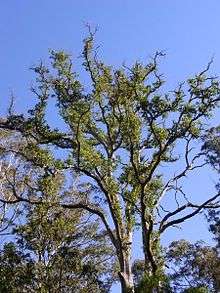Angophora subvelutina
| Broad-leaved apple | |
|---|---|
 | |
| Blue Mountains National Park, Australia | |
| Scientific classification | |
| Kingdom: | Plantae |
| (unranked): | Angiosperms |
| (unranked): | Eudicots |
| (unranked): | Rosids |
| Order: | Myrtales |
| Family: | Myrtaceae |
| Genus: | Angophora |
| Species: | A. subvelutina |
| Binomial name | |
| Angophora subvelutina F.Muell. | |
| Synonyms | |
|
Eucalyptus subvelutina F.Muell. | |
Angophora subvelutina, known as the Broad-leaved Apple, is a common woodland and forest tree of eastern Australia. Usually seen on river flats between 12 and 20 metres tall, though exceptional specimens exceed 35 metres tall. One of the habitats west of Sydney is on poorly drained alluvial flats near the Hawkesbury/Nepean river system. The explorer Allan Cunningham remarked that presence of these trees indicated fertile areas for agriculture. Adult leaves are similar in shape to eucalyptus leaves; opposite on the stem, oblong or ovate. 7 to 10 cm long and 3 to 5 cm wide.
The specific epithet subvelutina is from Latin, and it translates to "almost velvety".[1] Similar in habit to Angophora floribunda, however, it has dense more erect foliage, and the gumnuts are covered in felty reddish hairs.
Recently, genetic work has been published showing Angophora to be more closely related to Eucalyptus than Corymbia, and the name Eucalyptus subvelutina has been proposed for this species if it were to be placed in the eucalypt genus.

.
References
- ↑ Les Robinson - Field Guide to the Native Plants of Sydney, ISBN 978-0-7318-1211-0 page 24